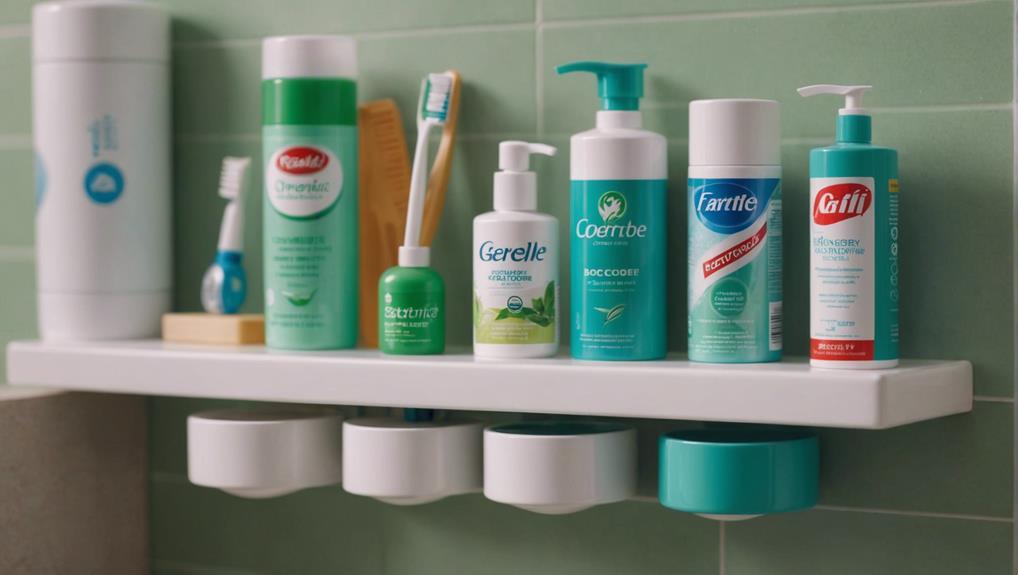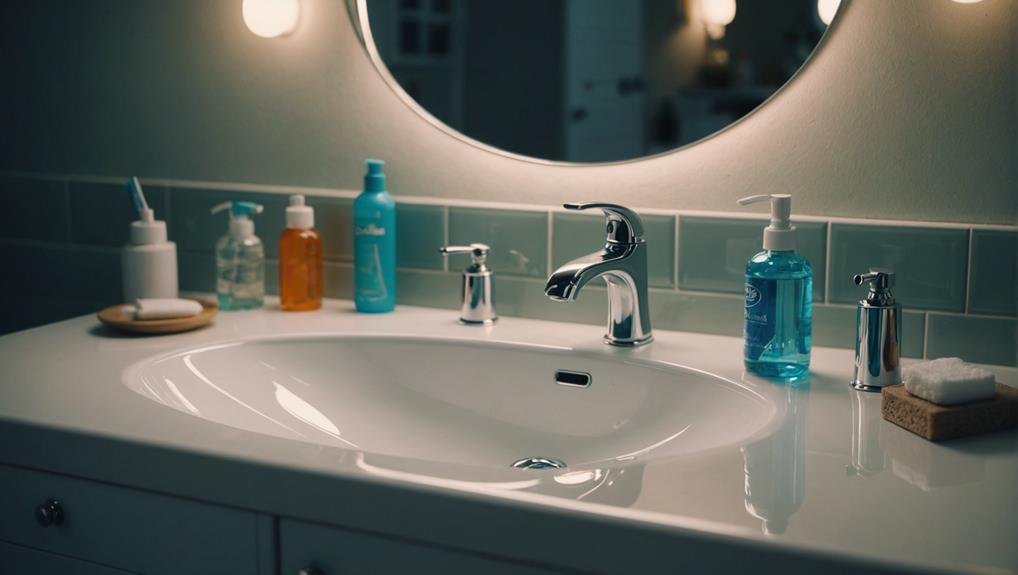Did you know that nearly 60% of adults experience bleeding gums at some point? This common issue often stems from inadequate oral hygiene but can be remedied with the right approach. You’re likely wondering how you can turn this around and guarantee your gums stay healthy. By adjusting your daily dental routine and using the proper tools and techniques, you can start to see improvements quickly. Let’s explore what changes you can make and why these steps are essential for not only stopping gum bleeding but also preventing it in the future. What’s the first step, you ask? Let’s find out.
Key Takeaways
- Use a soft-bristled toothbrush to reduce gum irritation and prevent bleeding.
- Apply gentle circular motions while brushing to protect sensitive gums.
- Choose toothpaste with stannous fluoride for its antibacterial and anti-inflammatory properties.
- Incorporate daily flossing using a ‘C’ shape technique to remove plaque without harming gums.
- Schedule regular dental visits for professional cleanings and personalized advice on gum health.
Choose a Soft-Bristled Toothbrush
Opt for a soft-bristled toothbrush to gently and effectively clean your teeth while protecting your gums from bleeding. When you choose a toothbrush that’s gentle on gums, you’re taking a critical step towards better oral health. A soft-bristled toothbrush reduces the risk of irritation, which is essential if your gums tend to bleed easily. It’s not just about avoiding pain; it’s about caring for the vulnerable parts of your mouth with the kindness they deserve.
Soft bristles are designed to be forgiving on sensitive gum tissue, preventing the harsh scraping that harder bristles can cause. This gentleness helps prevent bleeding and promotes better gum health over time. By using a soft-bristled toothbrush, you’re not only caring for yourself but also setting a standard of care that considers the comfort and health of others who might be facing similar issues.
Master Your Brushing Technique
To master your brushing technique, start by ensuring you brush for two minutes twice daily using a soft-bristled toothbrush. This simple tool is your best ally in combating gum issues and removing plaque effectively without harming your gums. Focus on using gentle circular motions, which help involve more surface area of each tooth and promote better cleaning. It’s essential to avoid aggressive brushing because it can damage your gums further and lead to increased sensitivity or bleeding.
Below is a table to help guide your brushing technique:
| Do | Don’t |
|---|---|
| Use gentle circular motions | Scrub hard back and forth |
| Brush for two minutes | Rush through brushing in under a minute |
| Replace your toothbrush regularly | Use old, frayed toothbrush bristles |
| Clean all tooth surfaces | Miss hard-to-reach areas |
| Hold your brush at a 45-degree angle | Hold your brush flat against teeth |
Select a Suitable Toothpaste

Choosing the right toothpaste is crucial for reducing gum bleeding and promoting overall gum health. When you’re helping someone manage their oral health, selecting a toothpaste that’s designed to prevent bleeding gums can make all the difference. Look for products containing stannous fluoride, a component known to strengthen gums and fend off gum diseases like gingivitis.
You’ll also want to ponder a toothpaste with antibacterial properties. Antibacterial toothpaste can target the root causes of bleeding gums, such as harmful bacteria and plaque buildup. By reducing these, you not only help prevent bleeding but also contribute to a healthier mouth environment.
If the person you’re caring for has sensitive gums, opt for a toothpaste specially formulated for sensitivity. These toothpastes are gentler and can reduce irritation, making brushing a more comfortable experience. It’s all about finding a toothpaste that addresses their specific needs while ensuring effectiveness against gingivitis and inflammation.
Incorporate Daily Flossing
Incorporating daily flossing into your oral care routine effectively removes plaque and food particles from between your teeth and along the gum line, helping to prevent bleeding gums. By engaging in this daily practice, you not only eliminate plaque build-up, which is a key cause of gum issues, but you also guarantee that your gums stay healthy and strong.
Flossing is a cornerstone of good oral hygiene. When done correctly, it can greatly reduce the chances that your gums bleed while brushing. To floss effectively, gently slide the floss between your teeth and curve it against each tooth in a ‘C’ shape. This method helps to dislodge food particles and plaque without harming your gums. Always use a fresh segment of floss for each tooth to avoid reinserting bacteria.
Making flossing a part of your daily oral care is essential in your mission to serve yourself and others by maintaining excellent health. It’s more than just keeping your smile attractive; it’s about preventing gum disease and ensuring that every aspect of your oral health contributes to your overall well-being. Remember, healthy habits like flossing do more than prevent problems—they’re an act of care for yourself and by extension, everyone you smile at.
Schedule Regular Dental Visits
Scheduling regular dental visits is important for maintaining healthy gums and preventing bleeding while brushing your teeth. By making appointments every six months, you’re not just ensuring your smile looks great; you’re taking a proactive step towards excellent oral health. These check-ups are essential as your dentist can spot early signs of gum disease that you might miss. Addressing these early can prevent more serious issues down the line.
During these visits, you’ll receive professional cleanings which are necessary in removing the buildup of plaque and tartar that daily brushing can’t manage alone. This thorough cleaning prevents gum bleeding, which can be a sign of gingivitis, the early stage of gum disease. Additionally, your dentist will provide personalized advice on proper oral care tailored specifically to your needs. They can recommend the best toothbrushes, toothpaste, and brushing techniques to help you prevent gum bleeding effectively.
Quit Smoking Habits
To enhance your gum health and stop bleeding while brushing, consider quitting smoking as it greatly increases the risk of gum disease. Smoking cessation is not just about breaking a bad habit; it’s about reclaiming your health and showing care for those around you. Smokers face a doubled risk of developing gum disease, which means you’re more likely to experience the discomfort and worry of bleeding gums.
Quitting smoking habits can dramatically halt the gum disease progression, giving your body a chance to heal and recover. You’ll notice that by avoiding tobacco products, not only do your gums thank you, but your overall oral hygiene improves. It’s a selfless act that benefits your personal health and serves as an example to others, potentially inspiring them to make healthier choices too.
Adopt a Gum-Healthy Diet
While quitting smoking is an important step, adopting a gum-healthy diet also plays a vital role in preventing bleeding gums. You can improve your gum health by incorporating foods rich in essential nutrients. Foods high in vitamin C, like oranges and red peppers, are not just tasty; they support gum health by strengthening the gum’s tissue. Vitamin C helps maintain the integrity of your gums, reducing the risk of bleeding.
Additionally, don’t forget to include vitamin K-rich foods such as spinach and kale in your meals. Vitamin K is critical as it aids in blood clotting, which can help stop bleeding should it start. Aiming for a daily intake of 65-90 milligrams of vitamin C and 120 micrograms of vitamin K will keep your gums in good shape.
Besides these vitamins, aim for a balanced diet low in sugar and processed foods. High sugar intake can lead to gum inflammation, exacerbating bleeding issues. Instead, munch on crunchy vegetables like celery and carrots, which not only clean your teeth naturally but also support overall gum health. Remember, a gum-healthy diet is a cornerstone in your journey to prevent gum disease and maintain a bright, pain-free smile.
Frequently Asked Questions
How Do You Stop My Gums From Bleeding When I Brush My Teeth?
If your gums bleed when you brush, start by switching to a soft-bristled toothbrush and gently brush in circular motions. Don’t press too hard; it’s all about being gentle. Rinse with water afterward and consider using an antiseptic mouthwash to combat inflammation. Make sure you’re keeping up with regular dental check-ups too. These simple adjustments can make a big difference in keeping your gums healthy and bleed-free!
How Do You Stop Bleeding in the Mouth?
To stop bleeding in your mouth, apply gentle pressure with clean gauze to the affected area. Rinse with cold water to constrict blood vessels and reduce bleeding. Use an antibacterial mouthwash to clean and prevent infection. Avoid hot, spicy foods that could irritate your gums further. If the bleeding doesn’t stop, it’s important to see your dentist to address any underlying issues and get the appropriate treatment.
How to Stop Tooth Bleeding?
To manage tooth bleeding, start by using a soft toothbrush and gentle circular strokes. Don’t forget to brush along the gum line to thwart plaque build-up. After brushing, rinse thoroughly with water and consider swishing with an antiseptic mouthwash to lessen inflammation. Regular dental check-ups are vital too. Adopting these habits not only helps stop the bleeding but also boosts your overall gum health. Stay consistent for the best results!
How Do You Stop Gum Bleeding Naturally?
To naturally stop gum bleeding, you can rinse your mouth with warm salt water, which reduces bacteria and aids healing. Applying aloe vera gel soothes inflammation, while tea tree oil offers antibacterial benefits. Clove oil is great for its anti-inflammatory properties, and a turmeric paste can be applied to your gums for added antibacterial effects. These simple remedies can effectively manage and prevent gum bleeding at home.
Conclusion
So, you’ve got the tools and the know-how to kick bleeding gums to the curb! Brush gently with a soft-bristled buddy, finesse your technique, and pick the right paste. Don’t forget to floss daily and check in with your dentist regularly. Kick those smokes to the curb and munch on gum-loving grub. Follow these steps, and you’ll be saying goodbye to bleeding gums and hello to a healthier, happier smile. You’ve got this!

